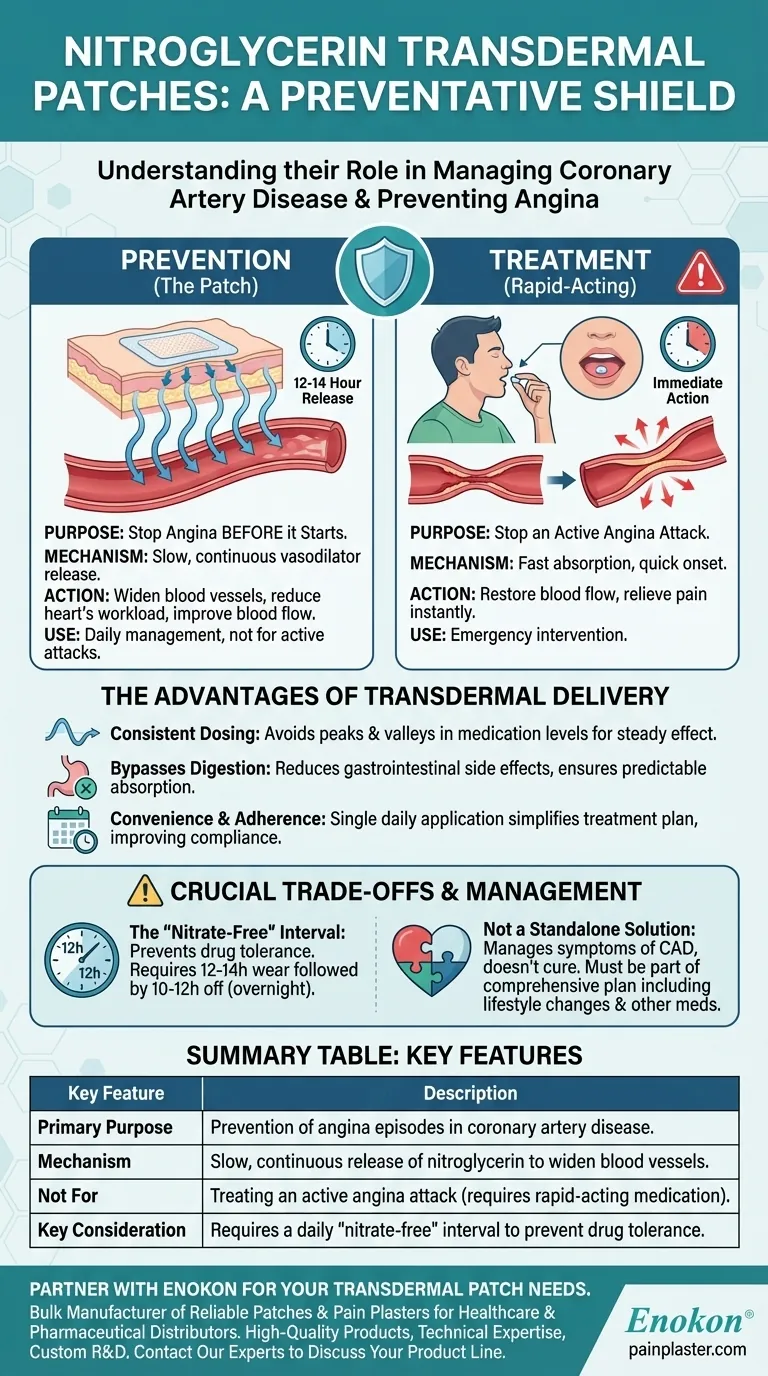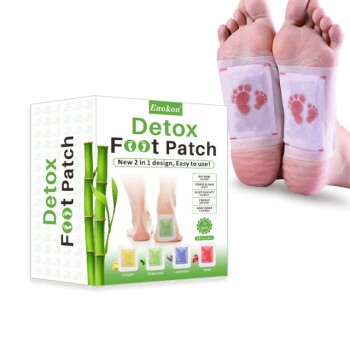In short, a nitroglycerin transdermal patch is a preventative tool. Its sole purpose is to stop episodes of angina (chest pain) before they start in people with coronary artery disease. It achieves this by slowly and continuously releasing medication through the skin to widen blood vessels, but it works too slowly to treat a chest pain attack that is already underway.
The key takeaway is to understand the delivery system: the patch is designed for slow, sustained release to provide long-term prevention. This is fundamentally different from the rapid-acting medications required to stop an acute angina attack in an emergency.

The Core Mechanism: Prevention, Not Treatment
The distinction between preventing a problem and treating it once it occurs is the most critical concept for understanding nitroglycerin patches.
How the Patch Prevents Angina
A nitroglycerin patch delivers a steady, controlled dose of medication directly through the skin into the bloodstream. This medication acts as a vasodilator, meaning it relaxes and widens the blood vessels.
By keeping the vessels that supply the heart with blood wider, the patch reduces the heart's workload. This improves blood flow and oxygen supply, which prevents the painful imbalance that causes angina.
Why It Cannot Treat an Active Attack
An active angina attack is a medical urgency that requires immediate intervention. The medication must reach the heart quickly to restore blood flow and relieve pain.
The transdermal patch is engineered for a slow onset of action, releasing its contents over many hours. This makes it completely unsuitable for stopping an attack that has already begun. For that, a rapid-acting form of nitroglycerin (like a tablet under the tongue) is required.
The Role in Coronary Artery Disease (CAD)
CAD is a chronic condition characterized by the narrowing of coronary arteries. A nitroglycerin patch is a management tool, not a cure.
It helps manage the daily symptoms of CAD by maintaining a baseline level of vasodilation, making it less likely that physical exertion or stress will trigger a painful angina episode.
The Advantage of the Transdermal System
Using a patch to deliver medication is a specific choice with distinct benefits compared to pills or injections.
Consistent and Predictable Dosing
The patch provides a smooth and continuous drug delivery over a 12- to 14-hour period. This avoids the "peaks and valleys" in medication levels that can occur with oral pills taken multiple times a day.
Bypassing the Digestive System
Delivering medication through the skin allows it to bypass the stomach and liver. This can reduce certain gastrointestinal side effects and ensures a more predictable amount of the active drug enters the circulation.
Convenience and Patient Adherence
For many people, applying a single patch once a day is far more convenient than remembering to take multiple pills. This simplicity can significantly improve a patient's ability to stick to their prescribed treatment plan.
Understanding the Trade-offs
While effective, the transdermal patch is not without its limitations and requires proper management to remain effective.
The "Nitrate-Free" Interval
The body can quickly build a tolerance to nitroglycerin if exposed to it 24/7, making the drug less effective.
To prevent this, patients are instructed to have a "nitrate-free" period each day. This typically involves wearing the patch for 12-14 hours and then removing it for 10-12 hours (often overnight).
Not a Standalone Solution
The patch is one part of a comprehensive management plan for CAD. It manages symptoms but does not reverse the underlying disease. Lifestyle changes and other medications remain essential.
How to Apply This to Your Health Management
- If your primary focus is the long-term, daily prevention of angina: The transdermal patch is an excellent tool, offering convenience and steady medication delivery to reduce the frequency of chest pain.
- If you are experiencing an acute angina attack: The patch is the wrong tool for the job. You must use the rapid-acting medication prescribed by your doctor for immediate relief.
- If you are evaluating treatment options with your doctor: Discuss if the patch's convenience outweighs the need to maintain a strict daily "nitrate-free" interval to prevent tolerance.
Ultimately, recognizing the nitroglycerin patch as a proactive, preventative shield—not a reactive emergency treatment—is the key to using it safely and effectively.
Summary Table:
| Key Feature | Description |
|---|---|
| Primary Purpose | Prevention of angina episodes in coronary artery disease. |
| Mechanism | Slow, continuous release of nitroglycerin to widen blood vessels. |
| Not For | Treating an active angina attack (requires rapid-acting medication). |
| Key Consideration | Requires a daily "nitrate-free" interval to prevent drug tolerance. |
Partner with Enokon for Your Transdermal Patch Needs
As a bulk manufacturer of reliable transdermal patches and pain plasters, Enokon provides healthcare and pharmaceutical distributors and brands with the high-quality, consistent products detailed in this article. Benefit from our technical expertise for custom R&D and development to create effective solutions for your patients.
Contact our experts today to discuss how we can support your product line.
Visual Guide

Related Products
- Far Infrared Deep Heat Relief Patches Medicated Pain Relief Patches
- Heating Pain Relief Patches for Menstrual Cramps
- Capsaicin Chili Medicated Pain Relief Patches
- Far Infrared Heat Pain Relief Patches Transdermal Patches
- Icy Hot Menthol Medicine Pain Relief Patch
People Also Ask
- How does the Deep Heat Back Patch work? A Drug-Free Solution for Targeted Pain Relief
- How effective are pain relief patches for muscle pain? Target Localized Pain with Transdermal Delivery
- What are pain relief patches and how are they used? A Guide to Safe, Targeted Relief
- How do pain relief patches compare to other pain relief methods? Discover Targeted, Long-Lasting Relief
- How should pain relief patches be applied and used? A Guide to Safe & Effective Targeted Relief















